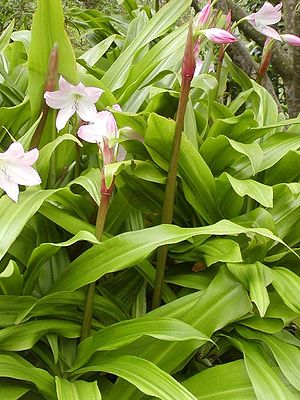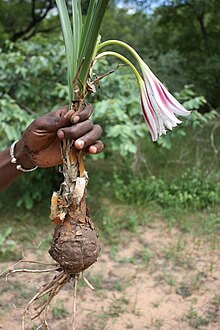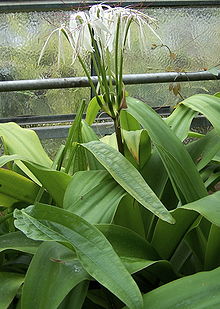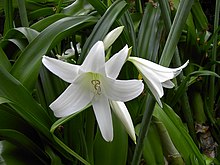Hook lilies
| Hook lilies | ||||||||||||
|---|---|---|---|---|---|---|---|---|---|---|---|---|

Bush hook lily ( Crinum moorei ) |
||||||||||||
| Systematics | ||||||||||||
|
||||||||||||
| Scientific name | ||||||||||||
| Crinum | ||||||||||||
| L. |
The Crinum ( Crinum ) are a genus within the family of the Amaryllis (Amaryllidaceae). The approximately 65 (up to 130) species are distributed in the coastal areas of the tropics and subtropics almost worldwide.
Description and ecology





Appearance and leaves
The Crinum species are perennial herbaceous plants that reach heights of growth of around 80 centimeters. They form onions as persistence organs.
Most species, as geophytes , retract their leaves during the dry season. The sessile, mostly (up to three meters) long foliage leaves, which are usually only arranged in a basal rosette, rarely distributed in two rows on the stem , are linear to sword-shaped and have parallel veins. The leaf margin is smooth.
Inflorescences and flowers
On a strong, long inflorescence stem there is a mostly multi-flowered, golden inflorescence ; the flowers are rarely solitary. In knospigen state two broad envelop bracts inflorescence. Often under the flower stalks there are linear or thread-like bracts that are membranous or sometimes colored. The flower stalks are more or less long.
The lily-shaped, large flowers are hermaphroditic and threefold. The flowers can be radial symmetry (then they belong to the subgenus Crinum ) or slightly zygomorphic (then they belong to the subgenus Codonocrinum ). The six identical bloom bracts are white in many species, pink to purple is also common, sometimes they are two-colored. The six stamens are bent differently depending on the species. Three fruit leaves are a dreikammerigen under constant ovary grown. Each ovary chamber contains two or more anatropic ovules . The long, sometimes curved stylus ends with a small, capitate or weakly three-lobed stigma . The nectar secretion occurs at the gynoeceum . In some species, the fragrant flowers are pollinated by long-nosed moths .
Fruits and seeds
Almost spherical to obovate capsule fruits are formed. The large seeds contain a lot of oily endosperm and can be winged or wingless.
ingredients
It contains the following toxic ingredients: Alkaloids : for example isoquinolines and lycorin .
Systematics







The genus Crinum was 1753 Linnaeus in Species Plantarum , 1, p 291 erected . As Lektotypusart 1923 Crinum americanum L. by Nathaniel Lord Britton and Percy Wilson in Scientific survey of Porto Rico and the Virgin Islands , tape set 5. S. 160th The botanical genus name Crinum is derived from the Greek word krinon for lily. Synonyms for Crinum L. are Tanghekolli Adans. , Bulbine Gaertn. nom. illeg., Scadianus Raf. , Crinopsis Herb. , Liriamus Raf. , Erigone Salisb. , Taenais Salisb.
The genus Crinum (from the Greek krinon = lily) belongs to the subtribe Crininae from the tribe Amaryllideae in the subfamily Amaryllidoideae within the family of Amaryllidaceae . It used to be part of the Liliaceae family.
The genus Crinum is divided into three sub-genera:
- Subgenus Stenaster
- Subgenus Crinum
- Subgenus Codonocrinum with the species Crinum abyssinicum , Crinum bulbispermum , Crinum fimbriatulum , Crinum graminicola , Crinum jagus , Crinum latifolium , Crinum macowanii , Crinum moorei , Crinum scabrum , Crinum zeylanicum .
The genus of the hook lilies ( Crinum ) comprises about 65 (up to 130) species in the tropics and subtropics almost worldwide:
- Crinum abyssinicum Hochst. ex A.Rich. (Syn .: Crinum schimperi Vatke ex K.Schum. ): It is common in northeastern tropical Africa in Eritrea , Ethiopia , Somalia and Sudan .
- Crinum acaule Baker : It occurs from eastern Maputaland and KwaZulu-Natal north of the Umfolozi River to southern Mozambique . It thrives in the coastal belt of the Indian Ocean and in the savannah on arid , sandy plains. At least in South Africa went through localities Cashew - plantations lost and forests. The South African populations are continuously decreasing. It was rated “Near Threatened” in the Red List of Endangered Plant Species in South Africa.
- Crinum album (Forssk.) Herb. (Syn .: Crinum yemense Deflers ): It occurs only on the southwestern Arabian Peninsula .
- Crinum × amabile Donn ex Ker Gawl. (Syn .: Crinum × augustum Roxb. , Crinum × amabile var. Augustum (Roxb.) Ker Gawl. , Crinum × superbum Roxb. ): This natural hybrid from Crinum asiaticum × Crinum zeylanicum comes u. a. in India before. In Hawai'i she is also called "Queen Emma Lily" (after Emma Na'ea Rooke ).
- Crinum amazonicum Ravenna : It is common in northern Brazil .
- Crinum americanum L. (Syn .: Crinum commelyni Redouté sensu auct., Crinum longiflorum Herb. , Crinum strictum Herb. Nom. Illeg., Crinum herbertianum Schult. & Schult f. , Crinum ceruleum Raf. , Crinum conicum M. Roem . , Crinum floridanum Griseb. , Crinum caribaeum Baker , Crinum roozenianum O'Brien , Crinum americanum subsp. Robustum L.S.Hannibal nom. Inval., Crinum americanum var. Traubii (Moldenke) LSHannibal , Crinum texanum L.S.Hannibal nom. Superfl.): It is from the southeastern USA to Mexico and on the Caribbean islands .
- Crinum amoenum Ker Gawl. ex Roxb. (Syn .: Crinum verecundum Carey ex Herb. , Crinum amoenum var. Verecundum (Carey ex Herb.) Herb. , Crinum himalense Royle ): It iswidespreadfrom the central Himalayas to Myanmar .
- Crinum amphibium Bjorå & Nordal : It occurs in Cameroon .
- Crinum arenarium Herb. (Syn .: Crinum australasicum Herb. Nom. Superfl., Crinum angustifolium R.Br. nom. Illeg., Crinum confertum Herb. , Crinum blandum (Herb.) M. Roem. , Crinum asiaticum var. Angustifolium (Herb.) Benth . , Crinum brisbanicum F.M.Bailey ): It is common in the northern Australian states of New South Wales , Queensland and Western Australia .
- Asiatic hook lily ( Crinum asiaticum L. ): It is widespread in the Indian Ocean, in tropical to subtropical Asia to islands in the south-western Pacific.
- Crinum aurantiacum Lehmiller : It occurs from Zambia to northern Malawi .
- Crinum bakeri K. Schum. : It occurs on islands in the northwestern Pacific.
- Crinum balfourii Baker : It only occurs on Socotra .
- Crinum bambusetum Nordal & Sebsebe : It occurs from western Ethiopia to Sudan . It was first described in 2002.
- Crinum belleymei Hérincq : It occurs in Paraguay.
- Crinum biflorum Rottb. : It occurs from tropical West Africa to southern Sudan.
- Crinum binghamii Nordal & Kwembeya : It was first described in 2004 from western Zambia.
- Crinum brachynema Herb. (Syn .: Crinum eleonorae leaf. & McCann ): It occurs in western India.
- Crinum braunii Harms : It occurs in Madagascar.
- Crinum brevilobatum McCue : It occurs in Costa Rica .
- Pink hook lily ( Crinum bulbispermum (Burm. F.) Milne-Redh. & Schweick. ): In South Africa the populations are decreasing . It occurs in southern Africa.
- Crinum buphanoides Welw. ex Baker : It is classified in the Red List of Endangered Species in South Africa as “least concern” = “not endangered”. It occurs in southern Africa and in southern tropical Africa.
- Narrow-leaved hook lily or permanent wave hook lily ( Crinum calamistratum Bogner & Heine ) It occurs in western Cameroon.
- Water-hook lily ( Crinum campanulatum Herb. ): It occurs only in the former Albany district between Alexandria, Makhanda , Bathurst and East London in the Eastern Cape . Only twelve isolated sites are known. The stocks are decreasing. In 2005 it was rated “Near Threatened” in the Red List of Endangered Plant Species in South Africa.
- Crinum carolo-schmidtii Dinter : It occurs from northern Botswana to the Caprivi Strip in Namibia.
- Crinum crassicaule Baker : It is classified in the Red List of Endangered Species in South Africa as “least concern” = “not endangered”. It occurs in southern Africa and in southern tropical Africa.
- Crinum darienense Woodson : It occurs in Panama .
- Crinum erubescens L. f. ex Aiton : It occurs from Mexico to Paraguay .
- Crinum erythrophyllum Carey ex Herb. : It occurs in Myanmar.
- Crinum filifolium H.Perrier : It occurs in western Madagascar.
- Crinum fimbriatulum Baker : It occurs in Angola .
- Crinum firmifolium Baker : It occurs in Madagascar.
- Crinum flaccidum Herb. : It occurs in western, central and eastern Australia.
- Crinum forgetii C.H.Wright : It occurs in Peru .
- Crinum giessii Lehmiller : It occurs in Namibia.
- Crinum glaucum A. Chev. : It occurs from tropical West Africa to Uganda .
- Crinum gracile G.Mey. ex C. Presl : It occurs from Malesia to New Guinea .
- Crinum graciliflorum Kunth & CDBouché : It occurs from Colombia to northern Venezuela .
- Crinum graminicola I. Verd. : It occurs from Namibia and in the South African provinces of Gauteng , KwaZulu-Natal, Limpopo , Mpumalanga and North West . It is classified in the Red List of Endangered Species in South Africa as “least concern” = “not endangered”.
- Crinum hanitrae Lehmiller & Sisk : It occurs in Madagascar.
- Crinum hardyi Lehmiller : It occurs in Madagascar.
- Crinum harmsii Baker : It occurs from northwestern Zambia to Namibia.
- Crinum hildebrandtii Vatke : It occurs in the Comoros .
- Crinum humile Herb. : It occurs in India.
- Crinum jagus (J.Thomps.) Dandy : It occurs in tropical Africa.
- Crinum jasonii Bjorå & Nordal : It was first described in 2007 from southeastern Zambia.
- Crinum joesmithii M.D.Barrett & RLBarrett : It was first described in 2015 from Western Australia.
- Crinum kakaduensis Lehmiller & Lykos : It was first described in 2013 and has so far only been found in the Australian state of Northern Territory on the Kakadu Highway .
- Crinum kirkii Baker : It occurs in Kenya, Tanzania and Mozambique .
- Crinum kunthianum M. Roem. : It occurs in Nicaragua, Colombia and Ecuador.
- Crinum lakefieldensis Lehmiller, Lykos & R.Ham. : It occurs only in the Australian state of Queensland.
- Crinum latifolium L .: It occurs from India to southern China (according to the Flora of China 2000 it does not occur in China).
- Crinum lavrani Lehmiller : It was first described in 2009 from Madagascar.
- Crinum linear L. f. : It occurs only in the South African province of Eastern Cape between Port Elizabeth and Peddie. In 2008 it was classified in the Red List of Endangered Plant Species in South Africa as "vulnerable" = "endangered".
- Crinum longitubum Pax : It occurs in Angola .
- Crinum lorifolium Roxb. : It occurs in India, Bangladesh and Myanmar.
- Crinum lugardiae N.E.Br. : It is classified in the Red List of Endangered Species in South Africa as “least concern” = “not endangered”.
- Crinum macowanii Baker : In South Africa the populations are decreasing. It occurs from Eritrea to southern Africa and the Seychelles.
- Crinum majakallense Baker : It occurs in Angola.
- Crinum malabaricum Lekhak & SRYadav : It occurs in the Indian state of Kerala . It was first described in 2012.
- Crinum mauritianum Lodd. : It used to occur in Mauritius .
- Crinum mccoyi Lehmiller : It occurs in Madagascar.
- Crinum minimum Milne-Redh. : It is classified in the Red List of Endangered Species in South Africa as “least concern” = “not endangered”. It occurs from Tanzania to southern tropical Africa.
- Crinum modestum Baker : It occurs in north-western Madagascar.
- Bush-hook lily ( Crinum moorei Hook. F. ): It occurs from the Eastern Cape to KwaZulu-Natal . In 2008 it was classified in the Red List of Endangered Plant Species in South Africa as "vulnerable" = "endangered".
- Crinum muelleri Lehmiller & Lykos : It wasfirst describedin 2013 from the Australian state of Northern Territory .
- Broad-leaved hook lily ( Crinum natans Baker ): It occurs in western and western-central tropical Africa.
- Crinum neroanum Lehmiller, Sisk & J. Zimmerman : It was first described in 2013 from Madagascar.
- Crinum nordaliae Mabb. : It occurs in Angola .
- Crinum nubicum Hannibal : It occurs from tropical West Africa to Chad .
- Crinum oliganthum Urb. : This endemic occurs only in central Cuba .
- Crinum ornatum (Aiton) Herb. : It occurs from tropical Africa to Namibia.
- Crinum paludosum Verd. : It occurs from southern Africa to southern tropical Africa.
- Crinum palustre Urb. : This endemic only occurs in Haiti .
- Crinum papillosum Nordal : It is classified in the Red List of Endangered Species in South Africa as “least concern” = “not endangered”. It occurs from southwestern Tanzania to northern Zambia.
- Crinum parvibulbosum Dinter ex Overkott : It occurs in Namibia.
- Crinum parvum Baker : It occurs in Mozambique.
- Crinum piliferum Nordal : It occurs in northern Kenya.
- Crinum politifolium R. Wahlstr. : It occurs in Tanzania.
- Crinum × powellii Baker = Crinum bulbispermum × Crinum moorei . It is an artificially created hybrid.
- Crinum pronkii Lehmiller : It was first described in 2009 from Madagascar.
- Crinum purpurascens Herb. : It occurs from tropical West Africa (Gambia) to Sudan and Angola in humid locations and sometimes also in rivers.
- Crinum pusillum Herb. : It only occurs on the Nicobar Islands .
- Crinum rautanenianum Schinz : It occurs from Zambia to northern Botswana .
- Crinum razafindratsiraea Lehmiller : It occurs in Madagascar.
- Crinum roperense Lehmiller & Lykos : It wasfirst describedin 2010 from the Australian state of Northern Territory .
- Crinum rubromarginatum Lehmiller : It occurs in Madagascar.
- Crinum salsum Ravenna : It occurs in the Brazilian state of Rio de Janeiro .
- Crinum scillifolium A. Chev. : It occurs in tropical West Africa.
- Crinum serrulatum Baker : It occurs in Cambodia .
- Crinum stapfianum Kraenzl. : It occurs in western and central Brazil.
- Crinum stenophyllum Baker : It occurs in Bangladesh and Myanmar.
- Crinum stracheyi Baker : It occurs in the Indian state of Uttarakhand .
- Crinum stuhlmannii Baker : It occurs in two subspecies from Somalia to southern Africa. In South Africa, stocks are decreasing.
- Crinum subcernuum Baker : It occurs from southeastern Tanzania to northern Botswana.
- Crinum surinamense Ravenna : It occurs in Surinam .
- Thailand hook lily or Thailand water lily ( Crinum thaianum J.Schulze ): It occurs in southern Thailand (western coastal region).
- Crinum trifidum Nordal : It occurs in Angola.
- Crinum ugentii (Ochoa) Molinari : The species found in Peru was first described in 2015.
- Crinum undulatum Hook. : It occurs in Brazil and northern Peru.
- Crinum uniflorum F. Muell. : It occurs in northern Australia.
- Crinum variabile (Jacq.) Herb. : It occurs only in the South African province of North Cape . The stocks are considered stable. In 2004 it was classified in the Red List of Endangered Species in South Africa as “least concern” = “not endangered”.
- Crinum venosum R.Br. : It occurs in northern Australia from northern Queensland to the northern Northern Territory .
- Crinum verdoorniae Lehmiller : It occurs from southern tropical Africa to the Kaprivi tip in Namibia.
- Crinum virgineum Mart. ex Schult. & Schult. f. : It is common in southeastern Brazil.
- Crinum viviparum (Lam.) R. Ansari & VJNair : It is widespread from the Indian subcontinent to Indochina.
- Crinum walteri Overkott : It occurs in southern Africa and in southern tropical Africa.
- Crinum wattii Baker : It occurs from Assam to Thailand and Myanmar.
- Crinum welwitschii Baker : It occurs in Angola.
- Crinum wimbushi Worsley : It occurs in Malawi .
- Crinum woodrowii Baker : It occurs in the Indian state of Maharashtra .
- Crinum xerophilum H.Perrier ex Lehmiller : It occurs only in southwestern Madagascar.
- Crinum yorkensis Lehmiller, Lykos & R.Ham. : It occurs in Queensland.
- Crinum zeylanicum (L.) L .: It occurs in Sri Lanka , southwest India and the Seychelles.
use
As an ornamental plant in parks and gardens and house plant mainly in is South Africa -based Kaplilie ( Crinum × powellii ) cultivated; it is a hybrid of the two South African species Crinum bulbispermum and Crinum moorei . Varieties of many species are used as ornamental plants in tropical to subtropical parks and gardens. There are also many hybrids.
Some of the species that also grow submerged , such as the permed hook lily ( Crinum calamistratum ), the broad-leaved hook lily or flooding hook lily ( Crinum natans ) and the Thailand hook lily ( Crinum thaianum ) are used as aquarium plants .
swell
- Zhanhe Ji, Alan W. Meerow: Amaryllidaceae. : Crinum , p. 265 - online with the same text as the printed work , In: Wu Zheng-yi, Peter H. Raven (Ed.): Flora of China. Volume 24: Flagellariaceae through Marantaceae , Science Press and Missouri Botanical Garden Press, Beijing and St. Louis, 2000, ISBN 0-915279-83-5 (section description)
- Walter C. Holmes: Crinum. , P. 278 - the same text online as the printed work , In: Flora of North America Editorial Committee (Ed.): Flora of North America North of Mexico. Volume 26: Magnoliophyta: Liliidae: Liliales and Orchidales , Oxford University Press, New York and Oxford, 2002. ISBN 0-19-515208-5 (section description)
- Crinum in the Western Australian flora . (Section description)
- Robert H. Archer: Data sheet with photos at Plantzafrica . (Section description)
literature
- AW Meerow, DJ Lehmiller & JR Clayton: Phylogeny and biogeography of Crinum L. (Amaryllidaceae) inferred from nuclear and limited plastid non-coding DNA sequences. In: Botanical Journal of the Linnean Society , Volume 141, 2003, pp. 349-363.
- Christel Kasselmann : aquarium plants. Ulmer, Stuttgart 1995; 2nd edition ibid 1999, ISBN 3-8001-7454-5 , pp. 171-173.
- Christel Kasselmann: Crinum. In: Claus Schaefer, Torsten Schröer (Hrsg.): The large lexicon of aquaristics. 2 volumes. Eugen Ulmer, Stuttgart 2004, ISBN 3-8001-7497-9 , p. 286 f.
Individual evidence
- ↑ Further information on lycorin and structural formula at giftpflanze.com .
- ^ Crinum at Tropicos.org. Missouri Botanical Garden, St. Louis, accessed October 19, 2014.
- ↑ a b c d e f g h i j k l m n o p q r s t u v w x y z aa ab ac ad ae af ag ah ai aj ak al am an ao ap aq ar as at au av aw ax ay az ba bb bc bd be bf bg bh bi bj bk bl bm bn bo bp bq br bs bt bu bv bw bx by bz ca cb cc cd ce cf cg ch ci cj ck cl cm cn co cp cq cr cs ct cu cv cw cx cy cz da db dc dd de df dg dh Rafaël Govaerts (Ed.): Crinum. In: World Checklist of Selected Plant Families (WCSP) - The Board of Trustees of the Royal Botanic Gardens, Kew . Retrieved July 26, 2018.
- ^ A b Crinum in the Germplasm Resources Information Network (GRIN), USDA , ARS , National Genetic Resources Program. National Germplasm Resources Laboratory, Beltsville, Maryland. Retrieved October 17, 2014.
- ↑ a b c d e f g h i j k l m n Species list for Crinum in the Red List of South African Plants . Retrieved October 19, 2014
- ↑ Crinum augustum the National Tropical Botanical Garden (US: Hawaii and Florida). ( Memento of the original from January 4, 2016 in the Internet Archive ) Info: The archive link was inserted automatically and has not yet been checked. Please check the original and archive link according to the instructions and then remove this notice.
- ↑ a b c d e f Walter Erhardt, Erich Götz, Nils Bödeker, Siegmund Seybold: The great pikeperch. Encyclopedia of Plant Names. Volume 2. Types and varieties. Eugen Ulmer, Stuttgart (Hohenheim) 2008, ISBN 978-3-8001-5406-7 .
- ↑ Christel Kasselmann: aquarium plants. 1999, p. 171.
- ↑ Christel Kasselmann: aquarium plants. 1999, p. 173.
- ↑ Christel Kasselmann: Crinum thaianum J. Schulze, 1971. In: Claus Schaefer, Torsten Schröer (ed.): The large lexicon of aquaristics. Eugen Ulmer, Stuttgart 2004, ISBN 3-8001-7497-9 , p. 287.
- ↑ Gordon Cheers (Ed.): Botanica. The ABC of plants. 10,000 species in text and images . Könemann Verlagsgesellschaft, 2003, ISBN 3-8331-1600-5 (therein pages 266-267).
- ↑ Christel Kasselmann: Crinum L., 1753. In: Claus Schaefer, Torsten Schröer (Hrsg.): The large lexicon of aquaristics. Eugen Ulmer, Stuttgart 2004, ISBN 3-8001-7497-9 , p. 286 f.
Web links
- The crinum.org .
- Entries about Crinum in Plants For A Future
- Entry in the Flora of Zimbabwe . (English)
- Entry in the Flora of Australia Online . (English)
- Entry at pacificbulbsociety.org.
- Crinum . In: U. Brunken, M. Schmidt, S. Dressler, T. Janssen, A. Thiombiano, G. Zizka: West African plants - A Photo Guide. Senckenberg Research Institute, Frankfurt am Main 2008.





